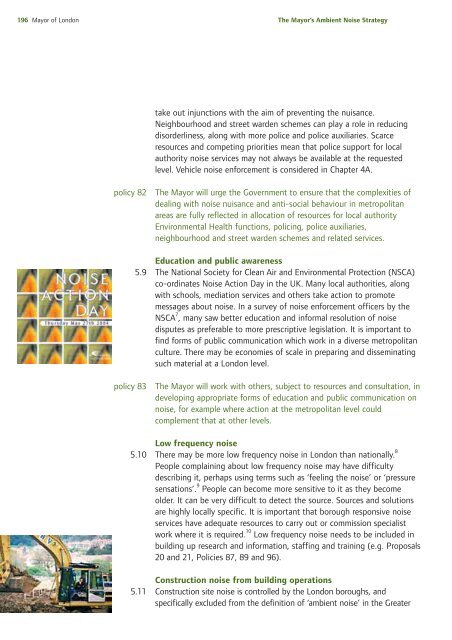The Mayor's Ambient Noise Strategy - Greater London Authority
The Mayor's Ambient Noise Strategy - Greater London Authority
The Mayor's Ambient Noise Strategy - Greater London Authority
Create successful ePaper yourself
Turn your PDF publications into a flip-book with our unique Google optimized e-Paper software.
196 Mayor of <strong>London</strong><br />
<strong>The</strong> Mayor’s <strong>Ambient</strong> <strong>Noise</strong> <strong>Strategy</strong><br />
take out injunctions with the aim of preventing the nuisance.<br />
Neighbourhood and street warden schemes can play a role in reducing<br />
disorderliness, along with more police and police auxiliaries. Scarce<br />
resources and competing priorities mean that police support for local<br />
authority noise services may not always be available at the requested<br />
level. Vehicle noise enforcement is considered in Chapter 4A.<br />
policy 82<br />
<strong>The</strong> Mayor will urge the Government to ensure that the complexities of<br />
dealing with noise nuisance and anti-social behaviour in metropolitan<br />
areas are fully reflected in allocation of resources for local authority<br />
Environmental Health functions, policing, police auxiliaries,<br />
neighbourhood and street warden schemes and related services.<br />
Education and public awareness<br />
5.9 <strong>The</strong> National Society for Clean Air and Environmental Protection (NSCA)<br />
co-ordinates <strong>Noise</strong> Action Day in the UK. Many local authorities, along<br />
with schools, mediation services and others take action to promote<br />
messages about noise. In a survey of noise enforcement officers by the<br />
NSCA 7 , many saw better education and informal resolution of noise<br />
disputes as preferable to more prescriptive legislation. It is important to<br />
find forms of public communication which work in a diverse metropolitan<br />
culture. <strong>The</strong>re may be economies of scale in preparing and disseminating<br />
such material at a <strong>London</strong> level.<br />
policy 83<br />
<strong>The</strong> Mayor will work with others, subject to resources and consultation, in<br />
developing appropriate forms of education and public communication on<br />
noise, for example where action at the metropolitan level could<br />
complement that at other levels.<br />
Low frequency noise<br />
5.10 <strong>The</strong>re may be more low frequency noise in <strong>London</strong> than nationally. 8<br />
People complaining about low frequency noise may have difficulty<br />
describing it, perhaps using terms such as ‘feeling the noise’ or ‘pressure<br />
sensations’. 9 People can become more sensitive to it as they become<br />
older. It can be very difficult to detect the source. Sources and solutions<br />
are highly locally specific. It is important that borough responsive noise<br />
services have adequate resources to carry out or commission specialist<br />
work where it is required. 10 Low frequency noise needs to be included in<br />
building up research and information, staffing and training (e.g. Proposals<br />
20 and 21, Policies 87, 89 and 96).<br />
Construction noise from building operations<br />
5.11 Construction site noise is controlled by the <strong>London</strong> boroughs, and<br />
specifically excluded from the definition of ‘ambient noise’ in the <strong>Greater</strong>
















